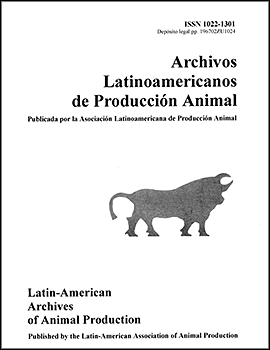
|
Archivos Latinoamericanos de Produccion Animal
Asociacion Latinoamericana de Produccion Animal
ISSN: 1022-1301
EISSN: 1022-1301
Vol. 16, No. 3, 2008, pp. 97-103
|
 Bioline Code: la08014
Bioline Code: la08014
Full paper language: English
Document type: Research Article
Document available free of charge
|
|
|
Archivos Latinoamericanos de Produccion Animal, Vol. 16, No. 3, 2008, pp. 97-103
| es |
Bernal, L.; Ávila, P.; Ramírez, G.; Lascano, C. E.; Tiemann, T. & Hess, H.
Resumen
Se evalúo el volumen de gas producido cuando se fermentaron ensilajes y henos de leguminosas taníferas. Se emplearon 28 tratamientos (14 con ensilajes y 14 con henos), 3 repeticiones por tratamiento y a 14 de ellos se les adicionó polietileno glicol (PEG) para inactivar los taninos. Los tratamientos ensilados fueron T1: Calliandra calothyrsus 100%, T2: Flemingia macrophylla 100%, T3: Vigna unguiculata 100%, T4: Cratylia argentea 100%, T5: Calliandra calothyrsus/Vigna unguiculata 33/67%, T6: Flemingia macrophylla/Vigna unguiculata 33/67%, T7: Cratylia argentea/Vigna unguiculata 33/67%. Henos: T8: Calliandra calothyrsus 100%, T9: Flemingia macrophylla, T10: Vigna unguiculata 100%, T11: Cratylia argentea 100%, T12: Calliandra calothyrsus/Vigna unguiculata 33/67%, T13: Flemingia macrophylla/Vigna unguiculata 33/67% y T14: Cratylia argentea/Vigna unguiculata 33/ 67%. La magnitud y la tasa de fermentación fue determinada utilizando la Técnica de Producción de Gas (TPG) propuesta por Theodorou et al (1994). Los datos de producción de gas obtenidos después de las 144 horas de incubación se ajustaron al modelo matemático de Gompertz. Los ensilajes presentaron mayor tasa de producción de gas que los henos (P<0.05). La adición de PEG no tuvo efecto sobre las varibles estudiadas. Hubo efecto del tipo de forraje incubado, la producción de gas fue mayor para Vigna que para Calliandra y Flemingia. El amonio (mmol/l) y la degradación de proteína (%) presentaron diferencia significativas (P<0.05) siendo mayor para henos, y para los forrajes Vigna y Cratylia que para Calliandra. Se concluye que la mezcla de leguminosas con taninos reduce la producción de gas, la liberación de amonio y la tasa de degradación de proteínas.
Palabras-clave
Calliandra calothyrsus, Cratylia argentea, Flemingia macrophylla, taninos, técnica de produccion gas, Vigna unguiculata.
|
| |
| en |
Efecto del ensilaje y el heno de Calliandra calothyrsus, Flemingia macrophylla, Cratylia argentea y Vigna unguiculata sobre la producciσn de gas in vitro
Bernal, L.; Ávila, P.; Ramírez, G.; Lascano, C. E.; Tiemann, T. & Hess, H.
Abstract
The volume of gas produced when tanniniferous legumes silages and hay were fermented was evaluated. 28 treatments (14 with silages and 14 with hays), 3 repetitions by treatment and 14 of them had polyethylene glycol (PEG) to inactive the tannins. The silages treatments were: T1: Calliandra calothyrsus 100%, T2: Flemingia macrophylla 100%, T3: Vigna unguiculata 100%, T4: Cratylia argentea 100%, T5: Calliandra calothyrsus/Vigna unguiculata 33/67%, T6: Flemingia macrophylla/Vigna unguiculata 33/67%, T7: Cratylia argentea/Vigna unguiculata 33/67%. Hays: T8: Calliandra calothyrsus 100%, T9: Flemingia macrophylla, T10: Vigna unguiculata 100%, T11: Cratylia argentea 100%, T12: Calliandra calothyrsus/Vigna unguiculata 33/67%, T13: Flemingia macrophylla/Vigna unguiculata 33/67% y T14: Cratylia argentea/Vigna unguiculata 33/67%. The magnitude and fermentation rate was determired using the Gas Trasducer Technique (GTT) proposed by Theodorou et al (1994). The gas production dates obtained after 144 hours or incubation to the Gompertz mathematic model were adjusted. The silages have greater rate of gas production than the hays (P<0.05). There was no effect of adittion of PEG. There was an effect of the type de forage incubated, being highest for Vigna than for Calliandra and Flemingia. The ammonium (mmol/l) and the protein degradation (%) were significant differences (P< 0.05) being highest for hays, and for the forages Vigna and Cratylia than for Calliandra. The mixture of legumes with tannins reduce the gas production, the ammonium liberation and the proteins degradation rate.
Keywords
Calliandra calothyrsus, Cratylia argentea, Flemingia macrophylla, taninos, Gas Trasducer Techinique (GTT) y Vigna unguiculata
|
| |
© Copyright 2008 Archivos Latinoamericanos de Produccion Animal.
Alternative site location: http://www.alpa.org.ve/ojs/index.php
|
|
